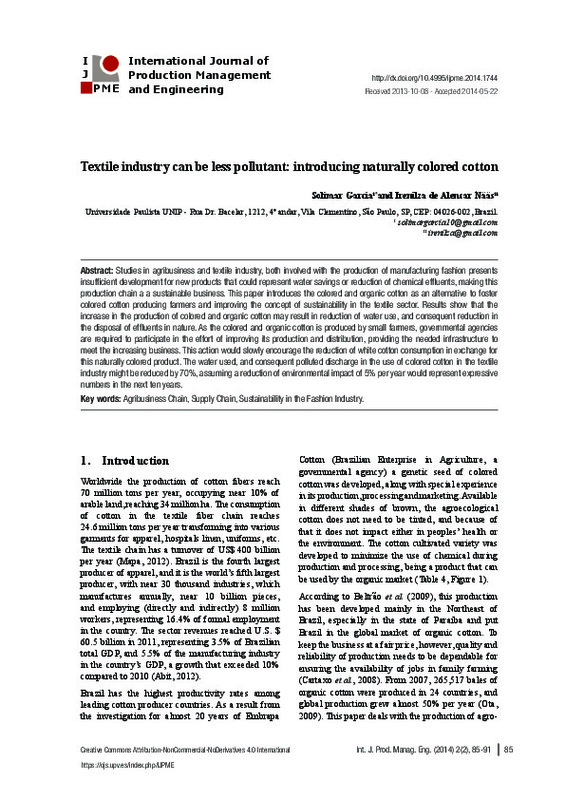Abreu, M. C. S. de, Castro, F. de, Soares, F. de A., & Silva Filho, J. C. L. da. (2012). A comparative understanding of corporate social responsibility of textile firms in Brazil and China. Journal of Cleaner Production, 20(1), 119-126. doi:10.1016/j.jclepro.2011.08.010
Baskaran, V., Nachiappan, S., & Rahman, S. (2012). Indian textile suppliers’ sustainability evaluation using the grey approach. International Journal of Production Economics, 135(2), 647-658. doi:10.1016/j.ijpe.2011.06.012
Carvalho, L. P. de, & Santos, J. W. dos. (2003). Respostas correlacionadas do algodoeiro com a seleção para a coloração da fibra. Pesquisa Agropecuária Brasileira, 38(1), 79-83. doi:10.1590/s0100-204x2003000100011
[+]
Abreu, M. C. S. de, Castro, F. de, Soares, F. de A., & Silva Filho, J. C. L. da. (2012). A comparative understanding of corporate social responsibility of textile firms in Brazil and China. Journal of Cleaner Production, 20(1), 119-126. doi:10.1016/j.jclepro.2011.08.010
Baskaran, V., Nachiappan, S., & Rahman, S. (2012). Indian textile suppliers’ sustainability evaluation using the grey approach. International Journal of Production Economics, 135(2), 647-658. doi:10.1016/j.ijpe.2011.06.012
Carvalho, L. P. de, & Santos, J. W. dos. (2003). Respostas correlacionadas do algodoeiro com a seleção para a coloração da fibra. Pesquisa Agropecuária Brasileira, 38(1), 79-83. doi:10.1590/s0100-204x2003000100011
Damiano VB (2003). As indústrias de materiais lignocelulósicos em busca de tecnologias amigas da natureza. Revista UNORP. v. 3, n. 2, p. 49-61.
Demir, A., Özdoğan, E., Özdil, N., & Gürel, A. (2010). Ecological materials and methods in the textile industry: Atmospheric-plasma treatments of naturally colored cotton. Journal of Applied Polymer Science, 119(3), 1410-1416. doi:10.1002/app.32575
Forgiarini E. (2006). Degradação de Corantes e Efluentes Têxteis PelaEnzima Horseradish Peroxidase (HRP). Dissertação de Mestrado do Programa de Pós–Graduação em Engenharia Química do Centro Tecnológico, da Universidade Federal de Santa Catarina. Florianópolis – Santa Catarina.
Galindo, C., Jacques, P., & Kalt, A. (2001). Photooxidation of the phenylazonaphthol AO20 on TIO2: kinetic and mechanistic investigations. Chemosphere, 45(6-7), 997-1005. doi:10.1016/s0045-6535(01)00118-7
Vautier, M., Guillard, C., & Herrmann, J.-M. (2001). Photocatalytic Degradation of Dyes in Water: Case Study of Indigo and of Indigo Carmine. Journal of Catalysis, 201(1), 46-59. doi:10.1006/jcat.2001.3232
Mendes FD. (2010). Um estudo comparativo entre as manufaturas do vestuário de moda do Brasil e da Índia. Tese de doutorado. Universidade Paulista. São Paulo: 2010.
Norum, P. S., & Ha-Brookshire, J. E. (2011). Consumer Trade-Off Analysis and Market Share Estimation for Selected Socially Responsible Product Attributes for Cotton Apparel. Clothing and Textiles Research Journal, 29(4), 348-362. doi:10.1177/0887302x11425956
Pan, Z., Sun, D., Sun, J., Zhou, Z., Jia, Y., Pang, B., … Du, X. (2010). Effects of fiber wax and cellulose content on colored cotton fiber quality. Euphytica, 173(2), 141-149. doi:10.1007/s10681-010-0124-0
Ramalho FS, Azeredo TL., Fernandes FS., Nascimento Júnior JL, Malaquias JB, Nascimento ARB, Silva CAD, Zanuncio JC. (2010). Food intake and utilization of Alabama argillacea (Hübner) (Lepidoptera: Noctuidae) fed on cotton cultivars with colored fibers. Journal of Pest Science.
[-]








